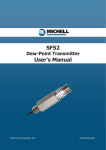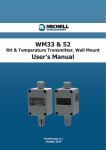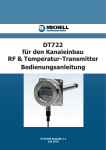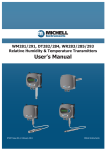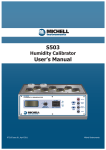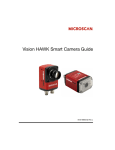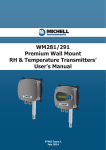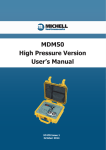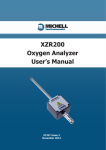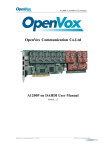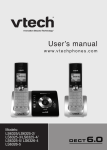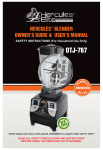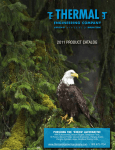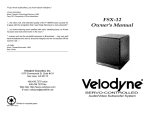Download DT722 User`s Manual
Transcript
DT722 RH & Temperature Transmitter, Duct Mount User’s Manual 97332 Issue 1 December 2012 Please fill out the form(s) below for each instrument that has been purchased. Use this information when contacting Michell Instruments for service purposes. Transmitter Code Serial Number Invoice Date Location of Instrument Tag No Transmitter Code Serial Number Invoice Date Location of Instrument Tag No Transmitter Code Serial Number Invoice Date Location of Instrument Tag No DT722 For Michell Instruments' contact information please go to www.michell.com © 2012 Michell Instruments This document is the property of Michell Instruments Ltd. and may not be copied or otherwise reproduced, communicated in any way to third parties, nor stored in any Data Processing System without the express written authorization of Michell Instruments Ltd. DT722 User’s Manual Contents Safety................................................................................................................................. v Electrical Safety............................................................................................................ v Toxic Materials.............................................................................................................. v Repair and Maintenance................................................................................................ v Calibration.................................................................................................................... v Safety Conformity......................................................................................................... v Abbreviations.......................................................................................................................vi Warnings.............................................................................................................................vi 1 2 3 Introduction.................................................................................................1 1.1 Features............................................................................................................. 1 INSTALLATION...................................................................................................2 2.1 Electrical Connections.......................................................................................... 2 Calibration and adjustment procedure.....................................................3 3.1 Calibration and Adjustment.................................................................................. 3 Figures Figure Figure Figure Figure Figure 1 2 3 4 5 DT722........................................................................................................1 Electrical Connections..................................................................................2 Connections................................................................................................3 Dimensions.................................................................................................6 Template....................................................................................................7 Appendices Appendix A Appendix B Appendix C Appendix D Appendix E Technical Specifications.................................................................................5 EC Declaration of Conformity.........................................................................9 Quality, Recycling & Warranty Information.................................................... 11 C.1 Recycling Policy............................................................................ 11 C.2 WEEE And RoHS Compliance......................................................... 11 C.3 Manufacturing Quality................................................................... 11 C.4 Calibration Facilities...................................................................... 12 C.5 Return Policy................................................................................ 12 C.6 Warranty...................................................................................... 12 Return Document & Decontamination Declaration......................................... 14 Recommended Practices in Humidity Measurements..................................... 16 iv 97332 Issue 1, December 2012 DT722 User’s Manual Safety The manufacturer has designed this equipment to be safe when operated using the procedures detailed in this manual. The user must not use this equipment for any other purpose than that stated. Do not apply values greater than the maximum value stated. This manual contains operating and safety instructions, which must be followed to ensure the safe operation and to maintain the equipment in a safe condition. The safety instructions are either warnings or cautions issued to protect the user and the equipment from injury or damage. Use competent personnel using good engineering practice for all procedures in this manual. Electrical Safety The instruments are designed to be completely safe when used with options and accessories supplied by the manufacturer for use with the instrument. Toxic Materials The use of hazardous materials in the construction of this instrument has been minimized. During normal operation it is not possible for the user to come into contact with any hazardous substance which might be employed in the construction of the instrument. Care should, however, be exercised during maintenance and the disposal of certain parts. Repair and Maintenance The instruments must be maintained either by the manufacturer or an accredited service agent. Refer to www.michell.com for details of Michell Instruments’ worldwide offices contact information. Calibration Michell Instruments recommends an annual calibration for an accuracy requirement of ±2% RH under ambient conditions where temperature is 0 to +50°C (+32 to +122°F) and relative humidity is 0 to 70% RH. For environments with airborne chemicals or for high humidity and high temperature conditions, more frequent calibration is recommended. Safety Conformity This product meets the essential protection requirements of the relevant EU directives. Further details of applied standards may be found in the product specification. Michell Instruments v DT722 User’s Manual INTRODUCTION Abbreviations The following abbreviations are used in this manual: ºC degrees Celsius ºF degrees Fahrenheit DC direct current g gram(s) “ inch(es) lb pound(s) mA milliampere mm millimeters % percentage oz ounce(s) RH relative humidity T temperature V Volts Warnings The following general warning listed below is applicable to this instrument. It is repeated in the text in the appropriate locations. Where this hazard warning symbol appears in the following sections it is used to indicate areas where potentially hazardous operations need to be carried out. vi 97332 Issue 1, December 2012 DT722 User’s Manual 1 INTRODUCTION Introduction The DT722 is a rugged, industrial, relative humidity and temperature transmitter designed for process applications where accurate, stable measurement and control of humidity and temperature is required. Figure 1 1.1 DT722 Features • Designed for accurate measurement in a harsh environment • Can withstand temperatures up to 150°C (300°F) • Stainless steel housing • Calculated moisture signal output - optional • Integral loop powered display – optional • Stainless steel housing available • 0 to 100% RH / -40 to +150°C operating ranges • Long term stability: ±1% RH over 12 months • M12 fast connector and cable gland Michell Instruments 1 DT722 User’s Manual INstallation 2 INSTALLATION 2.1 Electrical Connections Connections Cable Pin White Pin 1 SUPPLY + 8 to 32 V DC Yellow Pin 2 Output 2 = Temp 4-20 mA (max 500 Ω) Brown Pin 3 DO NOT CONNECT! (for calibration only) Green Pin 4 Output 1 = RH 4-20 mA (max 500 Ω) Pin 5 DO NOT CONNECT! (for calibration only) 2 3 Figure 2 5 1 4 Electrical Connections 2 97332 Issue 1, December 2012 DT722 User’s Manual 3 CALIBRATION Calibration and adjustment procedure • Calibration certifications: In addition to the normal calibration procedure, each transmitter can be supplied with its own traceable calibration certificate. Please ask Michell Instruments or your local distributor for more information. • Calibration interval time: Under normal ambient conditions (0 to 50°C, 0 to 70% RH) and for accuracy of ±2% RH, an annual calibration is recommended. For accuracy of ±5% RH a calibration is recommended every five years. For environments with airborne chemicals or of high humidity and high temperature conditions more frequent calibration is recommended. A humidity generator, (Michell Instruments S503, S904 or Optical), used in combination with a general reference handheld hygrometer, is ideal for a quick and accurate calibration. For more information on the S503, S904 or Optical humidity generators please contact Michell Instruments (see www.michell.com for contact details). 3.1 Calibration and Adjustment For recalibration and adjustment of the product please contact Michell Instruments (see www.michell.com for contact details). Figure 3 Connections Michell Instruments 3 DT722 User’s Manual appendix a Appendix A Technical Specifications 4 97332 Issue 1, December 2012 DT722 User’s Manual Appendix A appendix a Technical Specifications Performance Measurement Range (RH) 0–100% RH Measurement Range (T) Accuracy at 25°C (77°F) Humidity Accuracy at 25°C (77°F) Temperature Stability – RH Sensor Response time – RH Sensor -40 to +150°C (-40 to +302°F) <±2% RH (5-95% RH) ±0.2°C (±0.36°F) typical ±1% RH/year <10 sec typical (for 90% of the step change) Electrical Specifications Output Signal Supply Voltage Supply Voltage Influence 4-20 mA 8 to 32 V DC ±0.01% RH/V typical Operating Specifications Operating Humidity Probe, Housing, Storage Operating Temperature Probe Housing Storage 10 to 95% RH (non-condensing) -40 to +150°C (-40 to +302°F) -20 to +70°C (-4 to +158°F) -30 to +75°C (-22 to +167°F) Mechanical Specifications Ingress Protection Housing Material Dimensions Weight Electrical Connections IP65 (NEMA 4 level) Stainless steel Refer to Figure 4 - Dimensions 200mm / 800g (7.87” / 28.22oz) 300mm / 900g (11.81” / 31.75oz) 500mm / 1040g (19.69” / 36.68oz) 900mm / 1412g (35.43” / 49.80oz) 1500mm / 1970g (59.05” / 69.48oz) 5 pin, M12 Michell Instruments 5 DT722 User’s Manual appendix a Dimensions Figure 4 Dimensions 6 97332 Issue 1, December 2012 DT722 User’s Manual appendix a This drawing is actual size and can, therefore, be photocopied and used as a template when mounting the instrument. Figure 5 Template Michell Instruments 7 DT722 User’s Manual appendix B Appendix B EC Declaration of Conformity 8 97332 Issue 1, December 2012 DT722 User’s Manual Appendix B appendix B EC Declaration of Conformity EC Declaration of Conformity Manufacturer: Michell Instruments B.V. Krombraak 11 4906 CR Oosterhout Netherlands. We declare under our sole responsibility that the product: DT722 RH & Temperature Transmitter complies with all the essential requirements of the EC directives listed below. 2004/108/EC EMC Directive Using the standards: EN61326-1:2006 Electrical equipment for measurement, control and laboratory use – EMC requirements – Group 1, Class B (emissions) and immunity. and has been designed to be in conformance with the relevant sections of the following standards or other normative documents. EN61010-1:2010 Safety Requirements for Electrical Equipment for Measurement, Control, and Laboratory Use - Part 1: General Requirements Peter Haakma, Managing Director Michell Instruments B.V. Date of Issue: November 2012 Michell Instruments 9 DT722 User’s Manual appendix C Appendix C Quality, Recycling & Warranty Information 10 97332 Issue 1, December 2012 DT722 User’s Manual Appendix C C.1 appendix C Quality, Recycling & Warranty Information Recycling Policy Michell Instruments is concerned with the protection of the environment. It is our commitment to reduce and eliminate from our operations, wherever possible, the use of substances which may be harmful to the environment. Similarly, we are increasingly using recyclable and/or recycled material in our business and products wherever it is practical to do so. To protect natural resources and to promote material reuse, please separate batteries from other types of waste and recycle responsibly. If batteries are not properly disposed of, these substances can cause harm to human health and the environment. The product that you have purchased may contain recyclable and/or recycled parts and we will be happy to provide you with information on these components if required. C.2 WEEE And RoHS Compliance The Waste Electronic and Electrical Equipment (WEEE) Directive, and the Restriction of Hazardous Substances (RoHS) Directive place rules upon European manufacturers of electrical and electronic equipment. The directives’ aim is to reduce the impact that electronic devices have on the environment. Michell products are currently exempt from the RoHS directive, however all future products will be developed entirely using compliant materials. Furthermore, Michell is taking active steps to remove non-compliant materials and components from existing products wherever possible. Michell is in full compliance with the WEEE Directive (Registration No. WEE/JB0235YW). Customers may be required to return certain instruments for treatment at the end of their working life. June 2010 C.3 Manufacturing Quality Michell Instruments Ltd is registered with the British Standards Institute for Quality Assurance to: BS EN ISO 9001: 2008 Rigorous procedures are performed at every stage of production to ensure that the materials of construction, manufacturing, calibration and final test procedures meet the requirements laid down by our BSI approved Quality System. Please contact Michell Instruments (www.michell.com) if the product does not arrive in perfect working order. Michell Instruments 11 DT722 User’s Manual appendix C C.4 Calibration Facilities Each unit has an internal reference which is calibrated against our working factory standard and is traceable to ‘VSL’ in The Netherlands and National Physical Laboratory (NPL) in the UK. Calibration Certificates In addition to the normal calibration procedure, each internal reference transmitter can be supplied with its own VSL or NPL traceable calibration certificate. C.5 Return Policy If a Michell Instruments’ product malfunctions within the warranty period, the following procedure must be completed: C.6 1. Notify a Michell Instruments’ distributor, giving full details of the problem, the model variant and the serial number of the product. 2. If the nature of the problem indicates the need for factory service then the instrument should be returned to Michell Instruments, carriage prepaid, preferably in the original packaging, with a full description of the fault and the customer contact information. 3. Upon receipt, Michell Instruments will evaluate the product to determine the cause of the malfunction. Then, one of the following courses of action will be taken: • If the fault is covered under the terms of the warranty, the instrument will be repaired at no cost to the owner and returned. • If Michell Instruments determines that the fault is not covered under the terms of the warranty, or if the warranty has expired, an estimate for the cost of the repairs, at standard rates, will be provided. Upon receipt of the owner’s approval to proceed, the product will be repaired and returned. Warranty Unless otherwise agreed, the Supplier warrants that as from the date of delivery for a period of 12 months the goods and all their component parts, where applicable, are free from any defects in design, workmanship, construction or materials. The Supplier warrants that the services undertaken shall be performed using reasonable skill and care, and of a quality conforming to generally accepted industry standards and practices. Except as expressly stated all warranties whether express or implied, by operation of law or otherwise, are hereby excluded in relation to the goods and services to be provided by the Supplier. All warranty services are provided on a return to base basis. Any transportation costs for the return of a warranty claim shall reside with the Customer. 12 97332 Issue 1, December 2012 DT722 User’s Manual appendix D Appendix D Return Document & Decontamination Declaration Michell Instruments 13 DT722 User’s Manual appendix D Appendix D Return Document & Decontamination Declaration Decontamination Certificate IMPORTANT NOTE: Please complete this form prior to this instrument, or any components, leaving your site and being returned to us, or, where applicable, prior to any work being carried out by a Michell engineer at your site. Instrument Warranty Repair? Serial Number YES NO Company Name Original PO # Contact Name Address Telephone # E-mail address Reason for Return /Description of Fault: Has this equipment been exposed (internally or externally) to any of the following? Please circle (YES/NO) as applicable and provide details below Biohazards YES NO Biological agents YES NO Hazardous chemicals YES NO Radioactive substances YES NO Other hazards YES NO Please provide details of any hazardous materials used with this equipment as indicated above (use continuation sheet if necessary) Your method of cleaning/decontamination Has the equipment been cleaned and decontaminated? YES NOT NECESSARY Michell Instruments will not accept instruments that have been exposed to toxins, radio-activity or bio-hazardous materials. For most applications involving solvents, acidic, basic, flammable or toxic gases a simple purge with dry gas (dew point <-30°C) over 24 hours should be sufficient to decontaminate the unit prior to return. Work will not be carried out on any unit that does not have a completed decontamination declaration. Decontamination Declaration I declare that the information above is true and complete to the best of my knowledge, and it is safe for Michell personnel to service or repair the returned instrument. Name (Print) Position Signature Date F0121, Issue 2, December 2011 14 97332 Issue 1, December 2012 DT722 User’s Manual appendix E Appendix E Recommended Practices in Humidity Measurements Michell Instruments 15 DT722 User’s Manual appendix E Appendix E Recommended Practices in Humidity Measurements The following text is reproduced with kind permission from the National Physical Laboratory. It is originally published in the booklet, A Guide to the Measurement of Humidity. Definition of Relative Humidity Relative Humidity – The ratio of the actual vapor pressure to the saturation vapor pressure over a plane liquid water surface at the same temperature, expressed as a percentage. This is commonly understood when the term ‘X percent relative humidity’ is used. For actual vapor pressure, e, and saturation vapor pressure, es e relative humidity (in %) = ––– es x 100 USAGE: The phrase ‘relative humidity’ is commonly abbreviated RH although this is not a recognized abbreviation. Values of relative humidity are commonly expressed in units of percent relative humidity (% RH). Recommended practices in humidity measurements General practical recommendations • Where relative humidity is of interest, a direct measurement of relative humidity is usually best. Where an absolute measure of humidity is needed, choose dew point, vapor pressure or similar measurements. • Establish the measurement requirements at the purchasing stage in order to have the right instrument for the job. • Allow hygrometers to equilibrate in any new environment. This is particularly necessary after changes in temperature due to transportation or storage. Depending on the instrument and on how great the change in conditions, this may require from only a few minutes to many hours. • Follow Michell Instruments’ care instructions for the instrument. Some instruments need routine cleaning or other maintenance. Before using any solvent cleaner, check with Michell Instruments that this will not harm the sensor or other materials of construction. • Wherever possible, ensure that hygrometers are calibrated under the conditions of use, i.e. at similar values of humidity and temperature, and (if relevant) in similar conditions of pressure, airflow, etc. • Keep a record of calibrations and any adjustments to the hygrometer. This will show the long-term stability of the instrument and allow the associated uncertainty to be assessed. • Check instruments, if possible, at intervals between calibrations, by comparison with another (stable) instrument, to monitor for long-term drift. Routine checks are also useful before and after subjecting an instrument to transportation or other stress, which might lead to a shift in its performance. Where the check is against two (or more) instruments this is even better: not only does this add confidence, but in the event of one instrument drifting among a set of three, it can be seen which reading is most suspect. • Cleanliness of the environment will affect different hygrometers in different ways. Dust and airborne droplets should be avoided or filtered out if possible. Contaminants can come from the most surprising sources, ordinary urban pollution, for example. • The readings given by some types of hygrometer are sensitive to gas type. For any Instrument which reads in terms of mass per unit volume, e.g. in grams per cubic metre, it must be confirmed whether the calibration is valid for the gas in use. 16 97332 Issue 1, December 2012 DT722 User’s Manual • appendix E Avoid using instruments in direct sunlight or near any other source of heat, unless they are suitably shielded to prevent measurement errors. Sampling in general • Relative humidity measurements should be carried out at a representative temperature. Failure to allow temperature equilibration will lead to a false indication of the relative humidity. • Variations in vapor pressure from place to place can occur where an environment is subject to any addition or removal of water. If so, care must be taken over where to make a measurement in order to obtain a representative result. • Sources and sinks of water vapor should be avoided in any sampling system. Invasion of stray water can be minimised by attention to leaks, hygroscopic materials, droplets and condensation. The lower the humidity, the more critical these precautions are. • Hygroscopic materials should be avoided. Many materials contain moisture as part of their structure, particularly organic materials (whether natural or synthetic), salts (or anything which contains them), and anything which has small pores. Temperature changes can increase the tendency of these materials to affect the humidity of the surrounding air. • Condensation in a sampling process can invalidate humidity measurements by reducing the water content of the gas being measured. What is more, condensed liquid may alter the humidity elsewhere by dripping or running to other locations and evaporating there. In these circumstances, measurement results may be misleading if hygrometer location is not considered carefully. • Water droplets or mist must be avoided. These can result in overestimates of the humidity of the air between the droplets. Such results may exceed 100% RH, or may be impossible to interpret meaningfully. Droplets of liquid also damage some electrical types of humidity sensor. Filtering the air sample can eliminate droplets. • If pumps are used for sampling gas, these should be located after the hygrometer, to avoid contaminating the measurement environment. Where possible, oil free pumps should be used, or filters employed. Oscillations in pressure due to pumping can sometimes be reduced or buffered using a needle valve or a reservoir of large volume. • Special treatments such as filtration can change the amount of moisture in a gas. Some drying agents take out other gases, too. • When sealing any sensor or probe into a port or manifold in a duct or chamber, leaks through the probe or electrical cable should be considered. These are not always sealed against passage of ambient air. • Where sampling involves a step change in temperature, pressure or gas flow rate, relative to the process being sampled, results may need to be converted or interpreted. For example ‘pressure dew point’ will differ from the value found after expanding the gas sample to atmospheric pressure. Care should be taken to distinguish between ‘gauge’ and absolute values of pressure. Dew point in general • The measuring environment and all parts of the sampling pathway must be kept above the dew point if condensation is to be avoided. Electrical trace heating or other heating methods should be used if necessary. An excess temperature of 10°C above the dew point is usually a safe margin. • For measurements in the region below 0°C it must be clear whether the condensate is dew or frost. Failure to distinguish between these can result in errors of about 1°C for every 10°C below zero. Michell Instruments 17 appendix E DT722 User’s Manual Relative humidity in general • Due care must be taken of temperature. The effect of temperature on humidity is highly significant. Failure to take this into account can sometimes lead to errors so large that the measurement is meaningless. In many situations, the largest single source of uncertainty in a humidity measurement is the effect of temperature differences from place to place in the process, room or chamber. The importance of considering the temperature effects carefully cannot be overstated when relative humidity is the parameter of interest. • Care must be taken when expressing uncertainties, changes or fractional differences in relative humidity. For example, the difference between 50% RH and 52% RH is 2% RH. This can also be expressed as a difference of 4% of value. It is important to distinguish clearly between these two kinds of statement. Recommendations specific to ranges of measurements • Ambient humidity - Avoid using hygrometers near the body, which is a source of heat and moisture. Do not breathe close to the measurement. • High humidity, above the ambient range - Ample lines should be maintained above the dew point of the gas being measured, to avoid condensation. Electrical trace heating is often the most practical method. • Low humidity, and very dry gases - If possible, prepare for measurements by flushing sample lines and hygrometers with dry gas, or by evacuating to low pressure. Drive off stray residual water by baking assemblies if possible (but not instruments – unless designed for this!). The lower the moisture content to be measured, the more dramatically the required drying time multiplies. • Avoid hygroscopic materials. At low humidity (anything much below a dew point of 0°C) the amounts of water given off by organic and porous materials can dramatically affect the value of humidity. The lower the level of moisture, the more significant the effects. • Choose impermeable materials, to avoid inward diffusion of moisture through sampling tubes and enclosures. Steel and other metals are practically impermeable. PTFE (‘Teflon’) is only slightly permeable and will usually be satisfactory for dew points above -20°C, and sometimes below this level. Materials such as PVC and rubber are relatively permeable and so totally unsuitable at low humidity, and not really satisfactory in any humidity range. • Surface finish of pipework is important for very dry gases. Even the tiny quantities of water adsorbed on the surfaces of non-hygroscopic materials can have significant effect. Polished or electropolished steel is recommended for the best results. • Clean environments are always best for humidity measurements, but this is especially critical at very low humidity. Even fingerprints harbour water. High purity cleaning agents are recommended: Analytical Reagent (AR) quality solvents for oil-based contaminants, and purified water (distilled or de-ionised) for salts. Cleaning should be followed by thorough drying by a clean method. • Sample tubing should be as short in length as possible. The surface area should be minimised by using the narrowest tubing that the flow conditions will permit. • Avoid leaks. Minimising the number of connections (elbows, tees, valves, etc.) helps with this. • Adequate flow of the gas sample should be ensured, to minimise the influence of sources of stray water in the flow path. • ‘Dead ends’ should be avoided, as they cannot easily be flushed. • Back-diffusion of moisture should be minimised, e.g. by fast flow rates of gas, long exhaust tubes after the sensor, or by valves which isolate the low-humidity region from ambient air. 18 97332 Issue 1, December 2012 DT722 User’s Manual appendix E Practical recommendations for specific types of hygrometer Relative humidity capacitive sensor • Care should be taken to avoid mechanical shock (impact) or thermal shock (sudden temperature changes). Sensors should be protected from steam or water sprays, and from direct sunlight. • Where a sensor is at risk of exposure to dust, droplets, or the occasional knock during handling, the appropriate guard or filters for the sensor head should be used. • Any temptation to breathe on the sensor, or to wave it over cups of tea, etc. should be resisted. Filters and saturation guarding may protect the sensor, but these actions carry a risk of damage by condensation or other contamination. • Protective filters can slow the response time of sensors. This can be avoided by removing any filter, but the benefit must be weighed against the risk of damage to the sensor. • Sensors should not normally be submerged in liquids. In the case of a resistive (electrolytic) sensor, water or other liquids would certainly damage the sensor beyond repair. • Salt solutions are especially commonly used for calibration of electrical sensors, and should be provided with traceability directly or via a calibrated hygrometer. Protection of sensors from direct contact with salt or solution is most important as contamination would destroy or seriously impair the sensing element. Michell Instruments 19 DT722 User’s Manual NOTES 20 97332 Issue 1, December 2012 DT722 User’s Manual NOTES Michell Instruments 21 http://www.michell.com




























